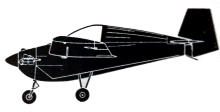
ASN Wikibase Occurrence # 222672
This information is added by users of ASN. Neither ASN nor the Flight Safety Foundation are responsible for the completeness or correctness of this information.
If you feel this information is incomplete or incorrect, you can submit corrected information.
| Date: | Thursday 18 October 2018 |
| Time: | |
| Type: |  Slingsby T.66 Nipper Mk III |
| Owner/operator: | Private |
| Registration: | OO-PVA |
| MSN: | A-116 |
| Fatalities: | Fatalities: 0 / Occupants: 1 |
| Aircraft damage: | Minor |
| Category: | Serious incident |
| Location: | Weesp, Noord-Holland -
 Netherlands Netherlands
|
| Phase: | En route |
| Nature: | Private |
| Departure airport: | Hilversum Airfield (EHHV) |
| Hilversum Airfield (EHHV) | |
| Investigating agency: | Dutch Safety Board |
| Confidence Rating: |
The aircraft took off from the Hilversum airfield on a local flight. During the first leg of the flight, the pilot detected vibrations in the aircraft. These vibrations disappeared after the engine speed was changed. Later in the flight, as he was pulling out of a looping, the pilot detected a different engine sound and an increased engine speed.
He concluded that the propeller had disappeared and made an emergency landing in a meadow. The pilot was unharmed. The detached propeller fell into a meadow without causing any damage. The engine cover sustained light damage due to the propeller separation.
In April 2018, the engine of the aircraft (Jabiru 2200A - 499 engine hours) had been subjected to a 100-hour periodical inspection and maintenance. The six propeller bolts had been replaced with new bolts and secured with lock-wire as part of the 500-hour replacement schedule. At the time of the incident, the engine had reached 532 running hours.
The mandatory 25-hour inspection at 524 engine hours had not been done.
The investigation revealed that five of the bolts with which the propeller flange is mounted onto the (engine) crankshaft flange had fractured. One bolt had not fractured but had been yanked from the crankshaft flange in its entirety, severely damaging the thread. When the five threads remaining in the crankshaft flange were removed, it was noted that these could be unscrewed without any resistance. Three of the bolt heads were still wired together with the lock-wire.
Microscopic investigation of the fracture surfaces shows fatigue fractures that started in the thread core. This means that the bolts had slowly detached during the course of the flight, steadily increasing the clearance between the propeller flange and the crankshaft flange.
This resulted in a combined bending moment and tensile force within the bolts, causing the bolts to eventually fracture due to excessive stress.
The engine manufacturer makes the following statement about the use of lock wire to secure propeller bolts: “no objection to lock-wire being used. However, lock-wire on its own has proven to be insufficient restraint for the screws. Loctite 620 must be used – all other restraints are optional”. However, no residue of Loctite 620 was found on any of the bolt thread sections. It was established that only lock-wire had been used instead of Loctite 620.
The periodical inspection and maintenance work had been done by an experienced service engineer. He had performed this operation several times before.
Furthermore, he stated that he was certain he had followed the correct procedure.
The engine had not been serviced in accordance with the manufacturer’s instructions. Failure to use the prescribed retaining compound caused the bolts with which the propeller was mounted onto the crankshaft to come undone. This led to fatigue fractures, which eventually resulted in the bolts breaking off. It is deemed unlikely that the absence of retaining compound would have been detected during the 25-hour inspection if it had been performed according to schedule, i.e. eight hours prior to the incident.
Sources:
https://www.onderzoeksraad.nl/nl/page/13657/verlies-van-propeller-tijdens-vlucht-tipsy-nipper-weesp-18-oktober
https://www.onderzoeksraad.nl/en/page/16567/kwartaalrapportage-luchtvaart-4e-kwartaal-2019
Revision history:
| Date/time | Contributor | Updates |
|---|---|---|
| 06-Mar-2019 19:37 | harro | Added |
| 24-Mar-2020 08:34 | harro | Updated [Nature, Departure airport, Destination airport, Source, Narrative] |
| 18-Jun-2022 13:02 | Ron Averes | Updated [Location] |
Corrections or additions? ... Edit this accident description
The Aviation Safety Network is an exclusive service provided by:


 ©2024 Flight Safety Foundation
©2024 Flight Safety Foundation